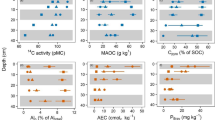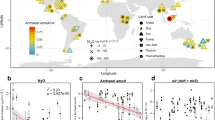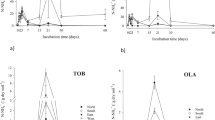Abstract
There is only limited understanding of the impact of high p(CO2) on soil biomes. We have studied a floodplain wetland where long-term emanations of temperate volcanic CO2 (mofettes) are associated with accumulation of carbon from the Earth's mantle. With an integrated approach using isotope geochemistry, soil activity measurements and multi-omics analyses, we demonstrate that high (nearly pure) CO2 concentrations have strongly affected pathways of carbon production and decomposition and therefore carbon turnover. In particular, a promotion of dark CO2 fixation significantly increased the input of geogenic carbon in the mofette when compared to a reference wetland soil exposed to normal levels of CO2. Radiocarbon analysis revealed that high quantities of mofette soil carbon originated from the assimilation of geogenic CO2 (up to 67%) via plant primary production and subsurface CO2 fixation. However, the preservation and accumulation of almost undegraded organic material appeared to be facilitated by the permanent exclusion of meso- to macroscopic eukaryotes and associated physical and/or ecological traits rather than an impaired biochemical potential for soil organic matter decomposition. Our study shows how CO2-induced changes in diversity and functions of the soil community can foster an unusual biogeochemical profile.
This is a preview of subscription content, access via your institution
Access options
Subscribe to this journal
Receive 12 digital issues and online access to articles
$119.00 per year
only $9.92 per issue
Buy this article
- Purchase on Springer Link
- Instant access to full article PDF
Prices may be subject to local taxes which are calculated during checkout




Similar content being viewed by others
References
Kämpf, H., Bräuer, K., Schumann, J., Hahne, K. & Strauch, G. CO2 discharge in an active, non-volcanic continental rift area (Czech Republic): characterisation (δ13C, 3He/4He) and quantification of diffuse and vent CO2 emissions. Chem. Geol. 339, 71–83 (2013).
Emiliani, C. Planet Earth: Cosmology, Geology, and the Evolution of Life and Environment (Cambridge Univ. Press, 1992).
Raven, J. A. The early evolution of land plants: aquatic ancestors and atmospheric interactions. Bot. J. Scotl. 47, 151–175 (1995).
Young, J. N., Rickaby, R. E. M., Kapralov, M. V. & Filatov, D. A. Adaptive signals in algal RuBisCO reveal a history of ancient atmospheric carbon dioxide. Phil. Trans. R. Soc. Lond. B 367, 483–492 (2012).
Blume, H.-P. & Felix-Henningsen, P. Reductosols: natural soils and technosols under reducing conditions without an aquic moisture regime. J. Plant Nutr. Soil Sci. 172, 808–820 (2009).
Mehlhorn, J., Beulig, F., Küsel, K. & Planer-Friedrich, B. Carbon dioxide triggered metal(loid) mobilisation in a mofette. Chem. Geol. 382, 54–66 (2014).
Rennert, T., Eusterhues, K., Pfanz, H. & Totsche, K. U. Influence of geogenic CO2 on mineral and organic soil constituents on a mofette site in the NW Czech Republic. Eur. J. Soil Sci. 62, 572–580 (2011).
Beulig, F. et al. Carbon flow from volcanic CO2 into soil microbial communities of a wetland mofette. ISME J. 9, 746–759 (2015).
McInerney, M. J. & Bryant, M. P. in Biomass Conversion Processes for Energy and Fuels (eds Sofer, S. S. & Zaborsky, O. R. ) 277–296 (Springer, 1981).
Ekschmitt, K. et al. Soil-carbon preservation through habitat constraints and biological limitations on decomposer activity. J. Plant Nutr. Soil Sci. 171, 27–35 (2008).
Burns, R. G. et al. Soil enzymes in a changing environment: current knowledge and future directions. Soil Biol. Biochem. 58, 216–234 (2013).
Urich, T. et al. Simultaneous assessment of soil microbial community structure and function through analysis of the meta-transcriptome. PLoS ONE 3, e2527 (2008).
Tveit, A., Schwacke, R., Svenning, M. M. & Urich, T. Organic carbon transformations in high-Arctic peat soils: key functions and microorganisms. ISME J. 7, 299–311 (2013).
Tveit, A. T., Urich, T., Frenzel, P. & Svenning, M. M. Metabolic and trophic interactions modulate methane production by Arctic peat microbiota in response to warming. Proc. Natl Acad. Sci. USA 112, E2507–E2516 (2015).
Hultman, J. et al. Multi-omics of permafrost, active layer and thermokarst bog soil microbiomes. Nature 521, 208–212 (2015).
Nieder, R. & Benbi, D. K. Carbon and Nitrogen in the Terrestrial Environment (Springer, 2008).
Schrumpf, M. et al. Storage and stability of organic carbon in soils as related to depth, occlusion within aggregates, and attachment to minerals. Biogeosciences 10, 1675–1691 (2013).
Gleixner, G., Danier, H.-J., Werner, R. A. & Schmidt, H.-L. Correlations between the 13C content of primary and secondary plant products in different cell compartments and that in decomposing Basidiomycetes. Plant Physiol. 102, 1287–1290 (1993).
Werth, M. & Kuzyakov, Y. 13C fractionation at the root–microorganisms–soil interface: a review and outlook for partitioning studies. Soil Biol. Biochem. 42, 1372–1384 (2010).
Conrad, R. Quantification of methanogenic pathways using stable carbon isotopic signatures: a review and a proposal. Org. Geochem. 36, 739–752 (2005).
Heuer, V. B., Pohlman, J. W., Torres, M. E., Elvert, M. & Hinrichs, K.-U. The stable carbon isotope biogeochemistry of acetate and other dissolved carbon species in deep subseafloor sediments at the northern Cascadia Margin. Geochim. Cosmochim. Acta 73, 3323–3336 (2009).
Rubino, M. et al. An isotopic method for testing the influence of leaf litter quality on carbon fluxes during decomposition. Oecologia 154, 155–166 (2007).
Kleber, M., Mikutta, R., Torn, M. S. & Jahn, R. Poorly crystalline mineral phases protect organic matter in acid subsoil horizons. Eur. J. Soil Sci. 56, 717–725 (2005).
Schneider, T. et al. Who is who in litter decomposition? Metaproteomics reveals major microbial players and their biogeochemical functions. ISME J. 6, 1749–1762 (2012).
Benner, R., Maccubbin, A. E. & Hodson, R. E. Anaerobic biodegradation of the lignin and polysaccharide components of lignocellulose and synthetic lignin by sediment microflora. Appl. Environ. Microbiol. 47, 998–1004 (1984).
Deangelis, K. M. et al. Evidence supporting dissimilatory and assimilatory lignin degradation in Enterobacter lignolyticus SCF1. Front. Microbiol. 4, 280 (2013).
Breznak, J. A. & Brune, A. Role of microorganisms in the digestion of lignocellulose by termites. Annu. Rev. Entomol. 39, 453–487 (1994).
McSweeney, C. S., Dulieu, A., Katayama, Y. & Lowry, J. B. Solubilization of lignin by the ruminal anaerobic fungus Neocallimastix patriciarum. Appl. Environ. Microbiol. 60, 2985–2989 (1994).
García, A. et al. Characterization of lignins obtained by selective precipitation. Sep. Purif. Technol. 68, 193–198 (2009).
Drake, L., Küsel, K. & Matthies, C. Acetogenic prokaryotes. Prokaryotes Prokaryotic Physiol. Biochem. 3–60 (2013).
Kuever, J. in The Prokaryotes (eds Rosenberg, E., DeLong, E. F., Lory, S., Stackebrandt, E. & Thompson, F. ) 281–288 (Springer, 2014).
Müller, M. et al. Biochemistry and evolution of anaerobic energy metabolism in eukaryotes. Microbiol. Mol. Biol. Rev. MMBR 76, 444–495 (2012).
Subramanian, V. et al. Profiling Chlamydomonas metabolism under dark, anoxic H2-producing conditions using a combined proteomic, transcriptomic, and metabolomic approach. J. Proteome Res. 13, 5431–5451 (2014).
Giordano, M., Beardall, J. & Raven, J. A. CO2 concentrating mechanisms in algae: mechanisms, environmental modulation, and evolution. Annu. Rev. Plant Biol. 56, 99–131 (2005).
Cardinale, B. J., Palmer, M. A. & Collins, S. L. Species diversity enhances ecosystem functioning through interspecific facilitation. Nature 415, 426–429 (2002).
Lara, E., Mitchell, E. A. D., Moreira, D. & López García, P. Highly diverse and seasonally dynamic protist community in a pristine peat bog. Protist 162, 14–32 (2011).
Van der Valk, A. G. The Biology of Freshwater Wetlands (Oxford Univ. Press, 2012).
Salih, F. M. Microalgae tolerance to high concentrations of carbon dioxide: a review. J. Environ. Prot. 2, 648–654 (2011).
Gessner, M. O. et al. Diversity meets decomposition. Trends Ecol. Evol. 25, 372–380 (2010).
Ward, N. L. et al. Three genomes from the phylum Acidobacteria provide insight into the lifestyles of these microorganisms in soils. Appl. Environ. Microbiol. 75, 2046–2056 (2009).
Kuever, J., Rainey, F. A. & Widdel, F. in Bergey’s Manual® of Systematic Bacteriology (eds Brenner, D. J., Krieg, N. R. & Staley, J. T. ) 922–1144 (Springer, 2005).
Bräuer, S. L., Cadillo-Quiroz, H., Ward, R. J., Yavitt, J. B. & Zinder, S. H. Methanoregula boonei gen. nov., sp. nov., an acidiphilic methanogen isolated from an acidic peat bog. Int. J. Syst. Evol. Microbiol. 61, 45–52 (2011).
Whitman, W., Boone, D., Koga, Y. & Keswani, J. Taxonomy of methanogenic archaea. Bergey’s Manual Syst. Bacteriol. 211–294 (2001).
Kubo, K. et al. Archaea of the Miscellaneous Crenarchaeotal Group are abundant, diverse and widespread in marine sediments. ISME J. 6, 1949–1965 (2012).
Lindroth, A. et al. Environmental controls on the CO2 exchange in north European mires. Tellus B 59, 812–825 (2007).
Waddington, J. M. & Roulet, N. T. Carbon balance of a boreal patterned peatland. Glob. Change Biol. 6, 87–97 (2000).
Wu, J., Roulet, N. T., Sagerfors, J. & Nilsson, M. B. Simulation of six years of carbon fluxes for a sedge-dominated oligotrophic minerogenic peatland in Northern Sweden using the McGill Wetland Model (MWM). J. Geophys. Res. Biogeosci. 118, 795–807 (2013).
Nowak, M. et al. Autotrophic fixation of geogenic CO2 by microorganisms contributes to soil organic matter formation and alters isotope signatures in a wetland mofette. Biogeosci. Discuss. 12, 14555–14592 (2015).
Mückenhausen, E. Die Bodenkunde und ihre geologischen, geomorphologischen und petrologischen Grundlagen (DLG-Verlag, 1993).
Kramer, C. & Gleixner, G. Variable use of plant- and soil-derived carbon by microorganisms in agricultural soils. Soil Biol. Biochem. 38, 3267–3278 (2006).
IUSS Working Group WRB. World Reference Base for Soil Resources 2006. World Soil Resources Report No. 103 (FAO, 2006).
Ad-Hoc-AG Boden . Bodenkundliche Kartieranleitung 5th edn (Schweitzerbart'sche Verlagsbuchhandlung, 2005).
Reiche, M., Gleixner, G. & Küsel, K. Effect of peat quality on microbial greenhouse gas formation in an acidic fen. Biogeosciences 7, 187–198 (2010).
Steinbeiss, S., Temperton, V. M. & Gleixner, G. Mechanisms of short-term soil carbon storage in experimental grasslands. Soil Biol. Biochem. 40, 2634–2642 (2008).
Steinhof, A., Adamiec, G., Gleixner, G., Wagner, T. & van Klinken, G. The new 14C analysis laboratory in Jena, Germany. Radiocarbon 46, 51–58 (2007).
Mook, W. G. & van der Plicht, J. Reporting 14C activities and concentrations. Radiocarbon 41, 227–239 (2006).
Reiche, M., Hädrich, A., Lischeid, G. & Küsel, K. Impact of manipulated drought and heavy rainfall events on peat mineralization processes and source-sink functions of an acidic fen. J. Geophys. Res. Biogeosci. 114, G02021 (2009).
Boschker, H. T. & Cappenberg, T. E. A sensitive method using 4-methylumbelliferyl-β-cellobiose as a substrate to measure (1,4)-β-glucanase activity in sediments. Appl. Environ. Microbiol. 60, 3592–3596 (1994).
Kang, H. & Freeman, C. Measurement of cellulase and xylosidase activities in peat using a sensitive fluorogenic compound assay. Commun. Soil Sci. Plant Anal. 29, 2769–2774 (1998).
Lueders, T., Manefield, M. & Friedrich, M. W. Enhanced sensitivity of DNA- and rRNA-based stable isotope probing by fractionation and quantitative analysis of isopycnic centrifugation gradients. Environ. Microbiol. 6, 73–78 (2004).
Lever, M. A. et al. A modular method for the extraction of DNA and RNA, and the separation of DNA pools from diverse environmental sample types. Front. Microbiol. 6, 476 (2015).
Meyer, F. et al. The metagenomics RAST server—a public resource for the automatic phylogenetic and functional analysis of metagenomes. BMC Bioinformatics 9, 1–8 (2008).
Fu, L., Niu, B., Zhu, Z., Wu, S. & Li, W. CD-HIT: accelerated for clustering the next-generation sequencing data. Bioinformatics 28, 3150–3152 (2012).
Li, H. & Durbin, R. Fast and accurate short read alignment with Burrows–Wheeler transform. Bioinformatics 25, 1754–1760 (2009).
Lanzén, A. et al. CREST—classification resources for environmental sequence tags. PLoS ONE 7, e49334 (2012).
Pruesse, E. et al. SILVA: a comprehensive online resource for quality checked and aligned ribosomal RNA sequence data compatible with ARB. Nucleic Acids Res. 35, 7188–7196 (2007).
Huson, D. H., Auch, A. F., Qi, J. & Schuster, S. C. MEGAN analysis of metagenomic data. Genome Res. 17, 377–386 (2007).
Hughes, J. B., Hellmann, J. J., Ricketts, T. H. & Bohannan, B. J. M. Counting the uncountable: statistical approaches to estimating microbial diversity. Appl. Environ. Microbiol. 67, 4399–4406 (2001).
Yin, Y. et al. dbCAN: a web resource for automated carbohydrate-active enzyme annotation. Nucleic Acids Res. 40, W445–W451 (2012).
Zhao, Y., Tang, H. & Ye, Y. RAPSearch2: a fast and memory-efficient protein similarity search tool for next-generation sequencing data. Bioinformatics 28, 125–126 (2012).
Acknowledgements
The authors thank H. Pfanz for motivation to work on the studied mofettes, K. Henkel for assistance during thermogravimetric analysis, J. Wendt and H. Geilmann for assistance with TOC and δ13C-TOC analysis, A. Hädrich, D. Akob, C. Simon, J. Kuhr and S. Vetter for help during sampling, and S. Kolb for discussions. Sequencing was performed by the Norwegian Sequencing Centre (www.sequencing.uio.no), a national technology platform supported by the Functional Genomics and Infrastructure programmes of the Research Council of Norway and the Southeastern Regional Health Authorities. This work was funded by the Deutsche Forschungsgemeinschaft through grant KU1367/10-1, the graduate research training group ‘Alternation and element mobility at the microbe–mineral interface’ (GRK 1257) and the German Centre for Integrative Biodiversity Research (iDiv) Halle-Jena-Leipzig.
Author information
Authors and Affiliations
Contributions
F.B. conceived, designed and performed the experiments, analysed the data and wrote the main paper. T.U. helped to design and analyse metatranscriptome and -genome sequencing experiments. M.N. performed radiocarbon measurements of soil and plant material and helped with 13C bulk soil measurements. S.E.T. and G.G. contributed to data discussion and structuring of the manuscript. G.D.G. and K.E.F. performed the metatranscriptome and -genome sequencing. F.B., K.K., S.E.T. and G.G. contributed to data discussion and structuring of the manuscript. All co-authors commented on and provided edits to the manuscript.
Corresponding author
Ethics declarations
Competing interests
The authors declare no competing financial interests.
Supplementary information
Supplementary Information
Supplementary Figures 1–4 and Tables 1–4 (PDF 1310 kb)
Rights and permissions
About this article
Cite this article
Beulig, F., Urich, T., Nowak, M. et al. Altered carbon turnover processes and microbiomes in soils under long-term extremely high CO2 exposure. Nat Microbiol 1, 15025 (2016). https://doi.org/10.1038/nmicrobiol.2015.25
Received:
Accepted:
Published:
DOI: https://doi.org/10.1038/nmicrobiol.2015.25
This article is cited by
-
Anaerobic degradation of organic carbon supports uncultured microbial populations in estuarine sediments
Microbiome (2023)
-
The community ecology perspective of omics data
Microbiome (2022)
-
The soil microbial food web revisited: Predatory myxobacteria as keystone taxa?
The ISME Journal (2021)
-
The value of soil respiration measurements for interpreting and modeling terrestrial carbon cycling
Plant and Soil (2017)
-
IMP: a pipeline for reproducible reference-independent integrated metagenomic and metatranscriptomic analyses
Genome Biology (2016)



